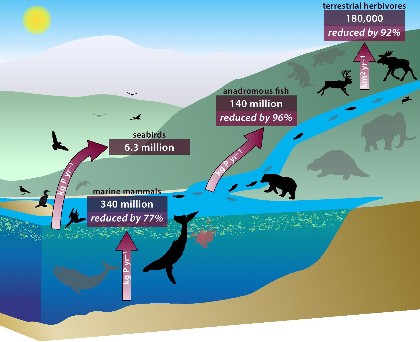A new study reveals how extinctions and significant population declines in large terrestrial and sea mammals that began during the end of the last Ice Age until today, are now depriving ecosystems of essential fertilizers via animal feces and urine, including the decomposition of their bodies after death.
Scientists identify these huge animals as whales, mammoths and mastodons, ground sloths, rhinos, including seabirds and salmon migration, that play crucial roles in the fertilizing of the Earth by incorporating and helping spread nutrients in oceans, rivers and deep inland.
According to ecologist Christopher Doughty from the University of Oxford, free ranging animals in the past apparently made it easier for nutrients to be distributed evenly, that led to increased global fertility.
The study also discovered that large mammals transported and recycled these nutrients that include phosphorous and nitrogen, to remote ecosystems that eventually boosted their vitality and productivity, from these animal migrations.
Now, this capacity of spreading nutrients from a concentrated source towards deep inland or seas to reach ecosystems is now down to 6 percent.
According to conservation biologist Joe Roman from the University of Vermont, in this sense, Earth was considered to be a land of giants up until humans colonized the planet. However, 150 of these colossal animals disappeared around 100,000 years ago due to human activities such as hunting and also, not being able to adapt quickly to the effects of climate change says Roman.
Doughty adds that among the 48 large, plant eating, land-dwelling species that thrived during the Ice Age, including 16 species of elephants and their cousins, nine rhino species and eight giant sloth species, only nine from these animals remain today.
Whales along with large marine mammals also contributed and transported some 750 million pounds of phosphorus from 100 meters deep into the ocean to the surface every year. However, commercial whaling practices cut global whale populations up to 90 percent where this capacity to distribute essential nutrients in the ocean has plummeted to 23 percent.
Ronan explains how great whales like humpbacks, blue whales and sperm whales are accustomed to diving deep to feed and then returning to the surface to breathe and digest. During this process, they also defecate, releasing poop and in turn, emitting essential nutrients such as nitrogen and phosphorus. These nutrients play an important role in algae growth, invertebrates an many fish populations as well.
This new study is published in the journal, Proceedings of the National Academy of Sciences.



























